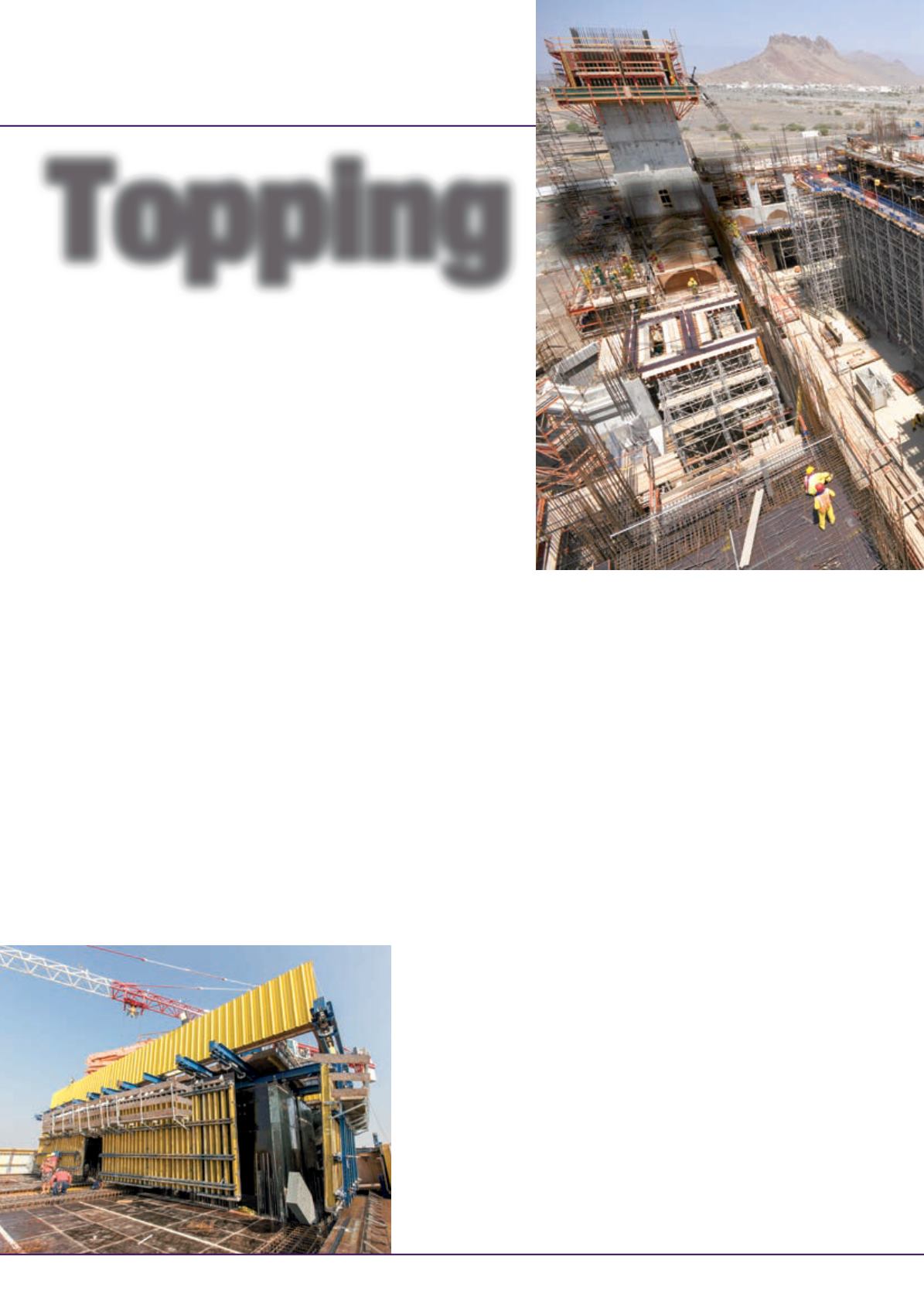
international
construction
september 2014
HIGHRISE
34
Topping out
As theworld’s 100th super-tall building tops out,
suppliers to the high-rise construction sector are raising
their game to ensure their technology keeps upwith
ambition.
SarahMcCay
reports
T
his year saw the 100th ‘super tall’ building of more than
300 m built when the Jiangxi Nanchang Greenland
Central Plaza, towers 1 and 2, topped out in June, in
China. The 303 m Jiangxi project is now the tallest building
complex inNanchang, stepping above the International Finance
Centre (239 m) and the still-under-construction Jiangxi
NanchangGreenlandZifengTower (268m).
More than half of the world’s tallest buildings have been built
in the last four years, with the total super tall category almost
tripling in the last seven years.
The world’s current tallest building – the Burj Khalifa in
Dubai, UAE – towers 828m above the desert. However, it will
lose its crown when the 1 km high KingdomTower in Jeddah,
Saudi Arabia is completed.Meanwhile, there are plans inChina
for the 1 km Phoenix Towers, inWuhan. If this project goes
ahead, it will undoubtedly be designed to eclipse the Kingdom
Tower.
For thoseworking in the construction sector, being involved in
a high-rise project canoftenmark the pinnacle of a career. From
architects with a sky-high vision, to contractors and equipment
manufacturers offering cranes, access equipment, formwork or
concrete pumps, high-rise often comes with high prestige and
high payout, alongside high build costs and high risk.
As architects getmore ambitious,manufacturers need to create
equipment that is up for the job, nomatter how high.
US manufacturer Reed offers a specially developed high-
rise concrete pump. A 164 kW Cummins Diesel and 180cc
main hydraulic pump powers the new C90S concrete pump.
According to Reed, the pump offers a maximum output of
69m
3
per hour, which allows for high-output vertical pumping.
FreddyAlmeidaofAlmeidaConcretePumpingandEquipment
is a dealer, distributor and supplier of theC90S.
“At moment we have four including ours, which are working
on buildings from 20 to 40 floors. Each one of these pumps is
used 2-3 times per week and is performing very well. One of
our customers just finished a 40+ storey building in Brooklyn,
while two inManhattan of 30+ floors and are currently being
worked on,”Mr. Almeida explained.
“This is one of the more affordable and faster ways to get a
job done with the least amount of manpower. We are seeing
more buildings raised up with companies using this type of
equipment, including the tallest buildings being built in New
York,” he added.
Frompumps to formwork, bothhavebeen the long-considered
constructionmethod of choice for high-rise developments.
Carillion Alawi is working with RMD Kwikform on the
construction of the US$ 64 million landmark Sultan Qaboos
Mosque inNizwa, Oman.The site has required shoring towers
of up to 43 m high, to support the casting of the mosque’s
dome, as well as concrete slabs and beams.
Innovative solution
Facedwith a change in programme sequencing, which required
both beams and slabs to be cast at the same time, engineers
from RMD Kwikform designed an innovative solution to
erect a run of Rapidshor shoring support inside the previously
erected Alshor Plus birdcage, specified for the initial works.
By combining both Carillion Alawi was able to speed up the
construction cycle for the project.
“The dome was the ultimate challenge,” admitted RMD
Kwikform regional sales manager, Bellphine Campbell.
Topping out
RMDKwikform placed a 900mmwide run of Rapidshor
shoringwithin the Alshor Plus birdcage support to speed up
construction at the Sultan QaboosMosque in Oman.
Doka’s SKE100
automatic
climbing
formwork
plus is used to
hydraulically
raise the
formwork
modules in a
manner that is
fully automated
at the Torre
Isozaki building
in Italy.


